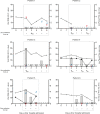Small quantities of respiratory syncytial virus RNA only in large droplets around infants hospitalized with acute respiratory infections
- PMID: 34193302
- PMCID: PMC8247131
- DOI: 10.1186/s13756-021-00968-x
Small quantities of respiratory syncytial virus RNA only in large droplets around infants hospitalized with acute respiratory infections
Abstract
Background: Respiratory syncytial virus (RSV) is a major cause of respiratory tract infections in young children. The predominant transmission routes for RSV are still a matter of debate. Specifically, it remains unclear if RSV can be transmitted through the air and what the correlation is between the amount of RSV in nasopharynx samples and in the air.
Methods: The amount of RSV in the air around hospitalized RSV infected infants in single-patient rooms was quantified using a six-stage Andersen cascade impactor that collects and fractionates aerosols and droplets according to size. RSV shedding in the nasopharynx of patients was followed longitudinally by quantifying RSV RNA levels and infectious virus in nasopharyngeal aspirates. Nose and throat swabs of parents and swabs of the patient's bedrail and a datalogger were also collected.
Results: Patients remained RSV positive during the air sampling period and infectious virus was isolated up to 9 days post onset of symptoms. In three out of six patients, low levels of RSV RNA, but no infectious virus, were recovered from impactor collection plates that capture large droplets > 7 μm. For four of these patients, one or both parents were also positive for RSV. All surface swabs were RSV-negative.
Conclusions: Despite the prolonged detection of infectious RSV in the nasopharynx of patients, only small amounts of RSV RNA were collected from the air around three out of six patients, which were primarily contained in large droplets which do not remain suspended in the air for long periods of time.
Keywords: Air sampling; Droplet transmission; Respiratory syncytial virus; Transmission routes; Viable six-stage Andersen cascade impactor.
Conflict of interest statement
The authors declare that they have no competing interests.
Figures

References
-
- Shi T, McAllister DA, O’Brien KL, Simoes EAF, Madhi SA, Gessner BD, et al. Global, regional, and national disease burden estimates of acute lower respiratory infections due to respiratory syncytial virus in young children in 2015: a systematic review and modelling study. Lancet. 2017;390:946–58. doi: 10.1016/S0140-6736(17)30938-8. - DOI - PMC - PubMed
Publication types
MeSH terms
Substances
Grants and funding
LinkOut - more resources
Full Text Sources

